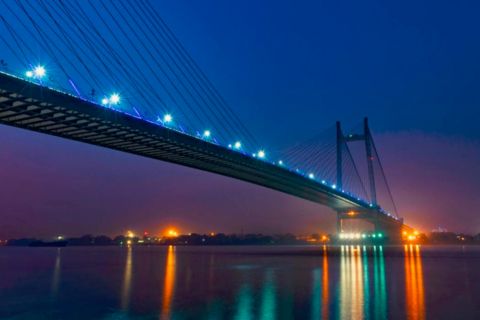Vivekananda Setu Kolkata Entry Fee
- No entry fee
Vivekananda Setu Kolkata Phone
N/A
Rating:  | 4/5 stars
| 4/5 stars
Based on total 49 reviews
Vivekananda Setu Kolkata Address: Bally, Howrah, Uttarpara, Kolkata, West Bengal, 711201, India
Popularly called Bally Bridge and Willingdon Bridge, the Vivekananda Setu is a bridge over the Hooghly River in West Bengal that connects the twin cities, Howrah at Bally, and Kolkata at Dakshineswar. The bridge is a multi span steel truss bridge with total 9 spans and is also the first ever rail cum road bridge ever built in India mainly to provide rail and road connectivity between Calcutta port (Sealdah - Dankuni Railway Line) and Howrah Railway Station. As far as the road connectivity is concerned, it connects the Barrackpore Trunk Road on Kolkata side (East bank) to the Grand Trunk Road on Howrah end (West bank).
The bridge is 2887 feet (880 meters) in length and is one of the 4 bridges that link Howrah and Kolkata. The Dakshineshwar temple is situated on the banks of the Hooghly River at the Kolkata end of the bridge.
Since it is almost a century old, the bridge has also undergone a lot of wear and tear and has seen the load of vehicles soar to around 24,000 per day with increase in population. This resulted in construction of a second Vivekananda Setu, apparently named Nivedita Setu parallel to the original bridge to share the load for the downstream traffic, i.e, Kolkata to Bally (Howrah) and was open for vehicular traffic in 2007.
Image Gallery of Vivekananda Setu Kolkata
Architecture of Vivekananda Setu
The bridge was built with a total of 9 spans, which include seven 350 feet main spans and two 80 feet land spans. There are eight main piers in the river, founded by octagonal steel caissons, each having 2 dredging holes of 19 feet diameter each. All the caissons were positioned by floating them, loading them with concrete at their respective foundations, the load thereby sustaining on compressed air buoyancy.
For both the road and the rail bridges, the foundation was laid with 100 feet well sinking down the riverbed. The erection, caissoning, girding, erection of abutments and arching, everything was done by Rai Bahadur Jagmal and his nameplate is still there in every single girder of the bridge. The girders are built of masonry piers, each 30 feet, the foundations of which are piled with reinforced concrete piles of 40 – 50 feet long. The viaducts consist of 22 spans of these girders.
The road bridge has 10 kilometer long approach roads on both sides and is almost a mile long. There are 3 coats of paint used to paint the entire bridge which includes a first coat of zinc chromate primer, a second coat of zinc chromate primer red oxide and a final coat of aluminum paint.
History of Vivekananda Setu
The construction of the bridge was started with the intention to bring the road and rail communication between Howrah and Kolkata, which was only done through waterways before that. The construction began in 1926 and was completed by 29th December 1931. It was built by the noted industrialist, contractor and philanthropist of the time, Rai Bahadur Jagmal Raja Chauhan, who was a noted Kutchi – Mestry railway contractor from Gujarat. He was responsible for the erection and caissoning of the structure whereas the fabrication was done by Braithwate & Company, Calcutta.
The original name of the now Vivekananda Setu was Willingdon Bridge, named in honor of the then Governor General and Viceroy of British India, Sir Freeman Thomas, the first Marquess of Willingdon. The Willingdon Bridge was inaugurated by Sir Freeman Thomas.
The total cost incurred for building the bridge was INR 1.14 crore, which equals to INR 300 crore or a little over USD 40 billion in today’s value.
The first train which ran across the Willingdon bridge was named Jagmal Raja Howrah Express, to honor the contribution of the builder of the bridge.
Places to visit around Vivekananda Setu
Dakshineshwar Temple, Belur Math, Howrah Bridge, New Market, New Town Eco Park, Victoria Memorial, St. Paul’s Cathedral, Birla Planetarium, Princep Ghat, Vidyasagar Setu, Fort William, Park Street are few places that can be visited.
How to Reach Vivekananda Setu
Nearest Airport – Netaji Subhash Chandra Bose Airport is 7.61 kilometers from Kolkata end of the Vivekananda Setu. You may easily hire a cab from top car rental companies in Kolkata and visit all the popular sightseeing places of Kolkata.
Nearest Railway Station – Dakshineshwar Railway Station at the Kolkata end and Howrah Railway Station at the Howrah end are two nearest railway stations to the bridge. You may either take a train from Howrah to Dakshineshwar or vice versa to enjoy a train ride across the bridge.
Are you looking for an all-inclusive Kolkata tour package? Then look no further than us. We at Kolkata Tourism, a division of Holidays DNA, take care of all your needs and design our packages keeping your budget and preferences in mind. You can also reach out to our team of experts for a tailor-made package or get more information by filling the Contact Us form.





